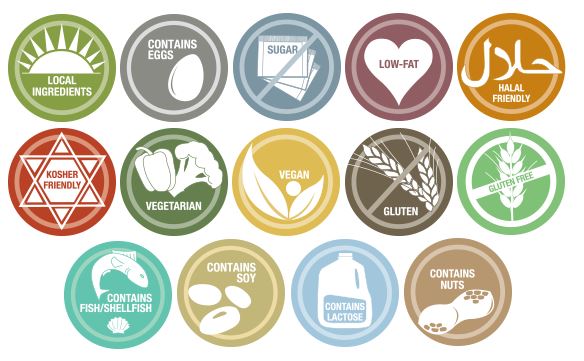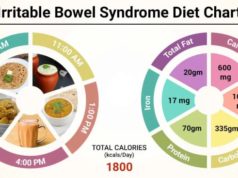People may follow many dietary restrictions for various reasons, including health, cultural or religious beliefs, personal preferences, or ethical considerations. Here are some of the most common types of dietary restrictions:
1. Vegetarianism: People who follow a vegetarian diet avoid meat, poultry, and fish but may consume eggs and dairy products.
Vegetarianism is a dietary pattern that avoids meat, poultry, fish, and sometimes other animal products such as eggs and dairy. Vegetarians typically consume a plant-based diet that includes fruits, vegetables, legumes, grains, nuts, and seeds.
ALSO READ:
Diet Myths for Pregnant Women that are Wrong
Some become vegetarians for health reasons, ethical concerns, environmental sustainability, or cultural or religious beliefs. There are different types of vegetarianism, including Lacto-Ovo vegetarians who consume dairy and eggs, Lacto-vegetarians who consume dairy but avoid eggs, and Ovo-vegetarians who consume eggs but avoid dairy.
Some vegetarians avoid animal-derived products such as honey, gelatin, and rennet. Vegetarians must ensure they meet their nutrient needs through a well-planned and balanced diet that includes adequate protein, iron, calcium, vitamin D, B12, and omega-3 fatty acids.
2. Veganism: Vegans avoid all animal products, including meat, poultry, fish, eggs, dairy, and honey.
Veganism is a lifestyle that excludes all forms of animal exploitation and cruelty, not just in the diet but also in other areas of life, such as clothing, personal care products, and entertainment. A vegan diet excludes all animal products, including meat, fish, poultry, dairy, eggs, and honey, and instead relies on plant-based foods such as fruits, vegetables, legumes, grains, nuts, and seeds.
Veganism is often chosen for ethical, environmental, or health reasons, as some studies suggest that a well-planned vegan diet can provide all necessary nutrients and reduce the risk of chronic diseases.
However, vegans need to be mindful of nutrient intake, particularly for protein, iron, calcium, vitamin D, vitamin B12, and omega-3 fatty acids, and to ensure they are getting enough of these nutrients through a well-planned and balanced diet, fortified foods, or supplements if necessary.
3. Pescetarianism: People who follow a pescetarian diet avoid meat and poultry but include fish and seafood.
Pescetarianism is a dietary pattern that involves abstaining from meat and poultry but includes fish and other seafood. People who follow a pescetarian diet consume a plant-based diet that includes fruits, vegetables, legumes, grains, nuts, seeds, fish, and other seafood as their primary source of animal protein.
Some pescetarians also consume dairy and eggs, while others do not. Pescetarianism is often chosen for health or environmental reasons, as fish and seafood are often considered a lean source of protein high in omega-3 fatty acids, which are beneficial for heart and brain health.
However, it’s important to note that some fish may contain high levels of mercury or other contaminants and that overfishing and unsustainable fishing practices can have negative environmental impacts. As with any dietary pattern, ensuring a pescetarian diet is well-planned and balanced to meet nutrient needs is important.
4. Flexitarianism: Flexitarians eat mostly vegetarians but occasionally meat or fish.
Flexitarianism is a dietary pattern similar to a vegetarian diet but allows for occasionally consuming meat and other animal products. Flexitarians primarily consume a plant-based diet that includes fruits, vegetables, legumes, grains, nuts, and seeds but may occasionally include meat, poultry, fish, or dairy.
The term “flexitarian” is a combination of the words “flexible” and “vegetarian” and is often used to describe people who are transitioning towards a vegetarian or vegan diet or who are seeking to reduce their consumption of meat for health or environmental reasons. Flexitarianism may offer some benefits of a plant-based diet, such as the reduced risk of chronic diseases while allowing for flexibility and variety in food choices.
Flexitarians must ensure they meet their nutrient needs, particularly protein, iron, calcium, vitamin D, vitamin B12, and omega-3 fatty acids, through a well-planned and balanced diet.
5. Gluten-free: People who follow a gluten-free diet avoid foods that contain gluten, a protein found in wheat, barley, and rye—a gluten-free diet includes most bread, pasta, and baked goods.
A gluten-free diet is a dietary pattern that involves avoiding gluten, a protein found in wheat, barley, rye, and some other grains. Gluten is commonly found in many foods, including bread, pasta, cereal, baked goods, and some non-food products such as cosmetics and medications.
Gluten-free diets are typically followed by people with celiac disease, a condition in which gluten triggers an immune response that damages the small intestine, and people with non-celiac gluten sensitivity or wheat allergy.
Following a gluten-free diet involves consuming naturally gluten-free foods, such as fruits, vegetables, legumes, and nuts, as well as foods specifically formulated or processed to be gluten-free, such as gluten-free bread and pasta.
It’s important for people following a gluten-free diet to read food labels carefully and to be aware of potential sources of gluten, as even small amounts of gluten can trigger a reaction in people with celiac disease or gluten sensitivity.
6. Lactose-free: People who are lactose intolerant avoid dairy products containing lactose, a sugar found in milk and other dairy products.
A lactose-free diet is a dietary pattern that involves avoiding lactose, a sugar found in milk and other dairy products. Lactose intolerance is a common condition in which people have difficulty digesting lactose, which can cause symptoms such as bloating, gas, and diarrhea.
Following a lactose-free diet involves avoiding or limiting dairy products such as milk, cheese, and yogurt, as well as some non-dairy products that contain lactose, such as processed foods and medications.
However, some people who are lactose intolerant may be able to tolerate small amounts of lactose, and there are also lactose-free dairy products available that have been treated to remove lactose.
People following a lactose-free diet must ensure they are getting enough calcium, vitamin D, and other nutrients commonly found in dairy products, either through lactose-free dairy products or other dietary sources such as fortified plant milk, leafy green vegetables, and calcium-fortified foods.
7. Kosher: Kosher diets follow specific dietary laws and restrictions based on Jewish law. This diet includes avoiding certain meat and dairy products and following specific preparation and cooking methods.
Kosher is a dietary practice that follows Jewish dietary laws, known as kashrut, which outlines which foods are allowed and prohibited for consumption. The term “kosher” means “fit” or “proper” in Hebrew and refers to foods that are considered suitable for consumption according to these laws.
Kosher dietary laws include restrictions on which animals can be eaten, how animals are slaughtered and prepared, and which types of food can be eaten together. For example, kosher meats must come from animals that have cloven hooves and chew their cud and must be slaughtered in a specific way by a trained Jewish ritual slaughterer.
Additionally, kosher dietary laws prohibit consuming certain animals, such as pigs and shellfish, and mixing meat and dairy products. The practice of kosher dietary laws is often seen as a way to maintain Jewish cultural identity and demonstrate reverence for God.
8. Halal: Halal diets follow specific dietary laws and restrictions based on Islamic law. This diet includes avoiding certain types of meat and following specific preparation and cooking methods.
Halal is a dietary practice that follows Islamic dietary laws, which outline which foods are allowed and prohibited for consumption. The term “halal” means “permissible” in Arabic and refers to foods considered suitable for consumption according to these laws.
Halal dietary laws include restrictions on which animals can be eaten, how animals are slaughtered and prepared, and which types of food can be eaten together.
For example, halal meats must come from animals that have been slaughtered specifically by a trained Muslim ritual slaughterer while facing Mecca and with the invocation of God’s name. Additionally, halal dietary laws prohibit the consumption of certain animals, such as pigs and predatory animals, and the consumption of alcohol and other intoxicants. Halal dietary laws are often seen as a way to maintain Islamic cultural identity and demonstrate reverence for God.
9. Paleo: People who follow a paleo diet avoid processed foods, grains, legumes, and dairy products and focus on consuming whole foods, such as meat, fish, fruits, and vegetables.
The paleo diet, also known as the Paleolithic or the caveman diet, is a dietary pattern based on the foods humans commonly consumed during the Paleolithic era, which dates back over 2 million years.
ALSO READ:
Difference Between Diet Coke and Coke Zero Sugar
The paleo diet emphasizes eating whole, unprocessed foods such as meat, fish, fruits, vegetables, nuts, and seeds while avoiding processed foods, grains, dairy products, and legumes. Proponents of the paleo diet believe that this way of eating is more in line with the genetic makeup of humans and that it can promote weight loss, improve metabolic health, and reduce the risk of chronic diseases such as heart disease, diabetes, and cancer.
However, critics of the paleo diet argue that it is too restrictive and may not provide all of the necessary nutrients for a healthy diet, particularly in terms of fiber, calcium, and vitamin D. Additionally, the paleo diet is not consistent with what is known about the actual diet of Paleolithic humans, and may not be appropriate or practical for all individuals.
10. Low-carb: People who follow a low-carb diet limit their intake of carbohydrates, such as bread, pasta, and rice, and focus on consuming protein and fat-rich foods.
A low-carb diet is a dietary pattern that involves reducing the intake of carbohydrates, typically to less than 130 grams per day or less than 30% of daily calories, and increasing protein and fat intake. Carbohydrates are a type of macronutrient found in many foods, such as grains, fruits, vegetables, and dairy products.
By limiting carbohydrate intake, the body is forced to use fat and protein as its primary energy source, which can lead to weight loss and improved metabolic health. Popular low-carb diets include the Atkins diet, the ketogenic diet, and the South Beach diet.
Some studies have shown that low-carb diets can effectively lose weight and improve blood sugar control in people with type 2 diabetes. However, critics of low-carb diets argue that they can be difficult to sustain over the long term and may lead to nutrient deficiencies if not followed carefully.
Additionally, not all carbohydrates are created equal, and some carbohydrates, such as fruits, vegetables, and whole grains, are important sources of fiber, vitamins, and minerals for overall health.
It’s important to note that some dietary restrictions may overlap or be combined for specific reasons. It’s always best to consult with a healthcare professional or registered dietitian before significantly changing your diet.























